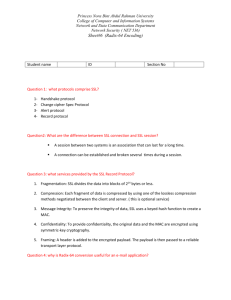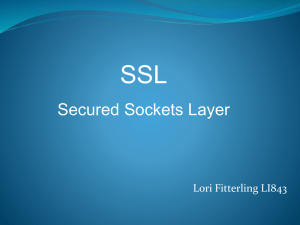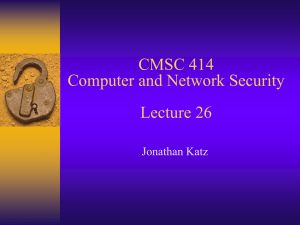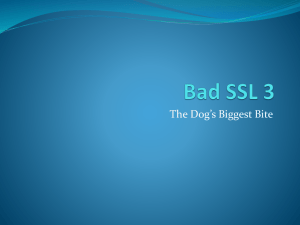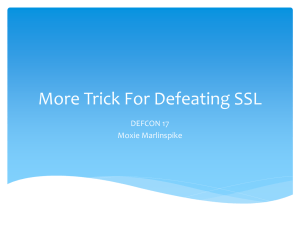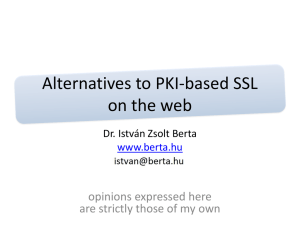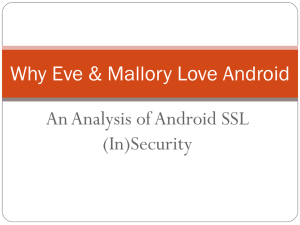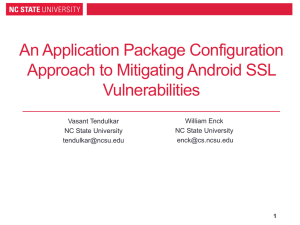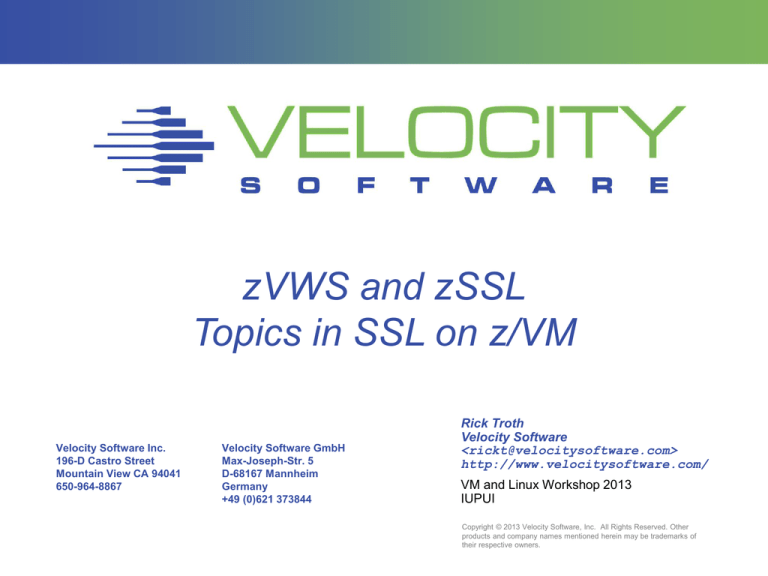
zVWS and zSSL
Topics in SSL on z/VM
Velocity Software Inc.
196-D Castro Street
Mountain View CA 94041
650-964-8867
Velocity Software GmbH
Max-Joseph-Str. 5
D-68167 Mannheim
Germany
+49 (0)621 373844
Rick Troth
Velocity Software
<rickt@velocitysoftware.com>
http://www.velocitysoftware.com/
VM and Linux Workshop 2013
IUPUI
Copyright © 2013 Velocity Software, Inc. All Rights Reserved. Other
products and company names mentioned herein may be trademarks of
their respective owners.
Disclaimer
The content of this presentation is informational only and is
not intended to be an endorsement by Velocity Software.
(ie: I am speaking only for myself.) The reader or attendee
is responsible for his/her own use of the concepts and
examples presented herein.
In other words: Your mileage may vary. “It Depends.”
Results not typical. Actual mileage will probably be less.
Use only as directed. Do not fold, spindle, or mutilate. Not to
be taken on an empty stomach. Refrigerate after opening.
In all cases, “If you can't measure it, I'm just not interested.”
2
Agenda
Crypto Concepts
SSL Basics
PKI Overview
Server Certificates – zSSL and VM SSL
Client Certificates – zSSL
Tools and Services
Related Topics
3
Symmetric Crypto
Early ciphers
Caesar
Jefferson
Enigma, Lorenz
Passwords
One-time use
Asymmetric Crypto
What if someone
got the password?
Rivest, Shamir, Adleman
involves a public key and a private key
hence … asymmetric
http://en.wikipedia.org/wiki/
Public-key_cryptography
Encryption plus Authentication
Encrypt with public key (of recipient)
Decrypt with secret key
Sign with secret key
Verify with public key (of sender)
Combo Crypto
Random “session key” symmetric (single)
Encrypt that with asymmetric (dual)
Encrypt payload with session key
Send asym-encrypted session key
and sym-encrypted payload
Transport Layer Security
Handshake authenticates
SSL provides a “channel”
Compare to SSH
Contrast with PGP/GPG (data at rest)
8
SSL Handshake
Authenticate the server
Establish a secure channel
Uses existing network
Does not protect “data at rest”
9
Public Key Infrastructure
CA certificate(s) pre-loaded
WS admin requests assertion
CA signs WS request
WS admin loads that
….....
Browser hits WS,
compares signature chain
Browser/WS agree on
session keys
10
Got zVWS? Then install zSSL
Insallation process for zSSL
automatically generates a key pair
and creates a self-signed server certificate.
Also creates a certificate request
which you can submit to your CA of choice.
11
VSIMAINT – install zSSL
12
VSIMAINT – configure zSSL
13
VSIMAINT – configure zSSL
14
VSIMAINT – X.509 data
15
VSIMAINT – keys, cert, req
16
Got zVWS? Then install zSSL
It's that easy!
Self-signed certificate is immediately ready.
Certificate request is available too.
Submit it to your CA of choice, if needed.
17
Server with Self-Signed Cert
18
Certificate Authorities – StartSSL
https://www.startssl.com/
19
Certificate Authorities – DigiCert
http://www.digicert.com/ssl-certificate.htm
20
Certificate Authorities – CACert
http://www.cacert.org/
21
Certificate Authorities – VeriSign
http://www.verisign.com/
22
VM SSL Key Management
Set up GSKADMIN and wire it into the stack
Sign onto GSKADMIN
Use 'gskkyman' command
23
VM SSL Key Management
24
VM SSL Key Management
Create a key database ...
Option 1
Filename “Database.kdb”
3700 days = 10 years, 6 weeks
Default record size
Fix file access ...
openvm permit /etc/gskadm/Database.kdb rw- r-- -openvm permit /etc/gskadm/Database.sth rw- r-- --
25
VM SSL Key Management
26
VM SSL Key Management
Create a self-signed certificate ...
Option 6
Option 7, server cert with 4096-bit RSA key
Option 3, SHA-256 signature digest
Enter a label, UPPER CASE
Enter X.509 stuff
Apply that label to a “secured” TCP port
27
VM SSL Key Management
Create new certificate request ...
Option 4
Option 3, cert with 4096-bit RSA key
Enter filename
Enter a label, UPPER CASE again
Enter X.509 stuff
File is PEM encoded; send to your CA
28
Client Certificates
To use client certificates, or devices like common
access cards, install a “CA bundle”.
CABUNDLE CRT ← in CONFIG directory
29
CA Bundle file
a collection of “signing certificates”
Copy ca-bundle.crt (eg: from Apache)
Create by hand (PEM encoded)
Create from example
Sample CA bundle can be found at:
http://curl.haxx.se/ca/cacert.pem
30
Client Certificates
CGI variables
SSL_CLIENT_S_DN, SSL_CLIENT_I_DN,
SSL_CLIENT_M_VERSION, SSL_CLIENT_M_SERIAL,
SSL_CLIENT_V_START, SSL_CLIENT_V_END,
SSL_CLIENT_A_KEY, and SSL_CLIENT_A_SIG
31
Crypto Concepts – Trust Models
Peer-to-Peer
PGP style
Third Party / Centralized
PKI style
Manual Assertion
Self-signed certificates
Question: which works best for your business?
32
Crypto Concepts – Proper Tools
SSL and TLS (PKI)
originally for HTTPS, now many protocols
third party trust
X.509 certificates
SSH
variable trust models
keys
PGP/GPG
peer-to-peer trust
keys
33
SSH
'ssh-keygen' command
Generates pub (“.pub”) and sec, two files
Append pub to “authorized_keys” file
of target user(s) on target system(s)
PGP/GPG
Generate a key pair
gpg --gen-key
Export your pub key, sign others
gpg --armor --export
gpg --sign-key other-user's-key
Import signed keys and signatures
gpg --import
Validating Stuff
36
DNSSEC
Domain Name System Security Extensions
Crypto Signing of Internet Domain Data
37
Key Management – Seahorse
38
Key Management – Seahorse
39
Terms and Tools to Learn
Certificates identified by SDN,
“subject distinguished name”
X.509 verbiage abounds
Need overview of BFS files (for VM SSL)
x /etc/gskadm/mycert.crq (nam bfs
What is a “subject”?
What is the “subject”?
That which is “signed” by an “authority”
What is the “authority”?
That which cryptographically signs the “subject”
41
Entropy
maximum entropy, minimum energy
maximum entropy, minimum “order”
Entropy ==> Randomness
Strong encryption
requires reliable randomness
42
Water Cooler Leaks
Human factors remain the biggest risk
Easy passwords
Gullible to scams
Easy-click assertion
Profiled for info
Unsecured hardware
Lost hardware
43
Back Channels?
44
Security Audit
A security auditor for our servers has demanded the following within two
weeks:
A list of current usernames and plain-text passwords for all user accounts
on all servers
A list of all password changes for the past six months, again in plain-text
A list of "every file added to the server from remote devices" in the past six
months
The public and private keys of any SSH keys
An email sent to him every time a user changes their password, containing
the plain text password
We're running Red Hat Linux 5/6 and CentOS 5 boxes with LDAP
authentication.
45
Summary
You need SSL
Apply SSL carefully
Understand the concepts
Be prepared:
SSL is a moving target!
46


